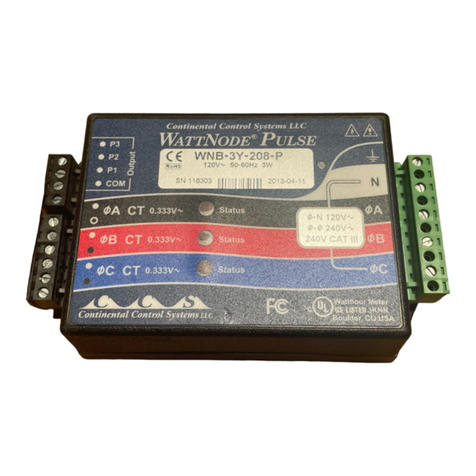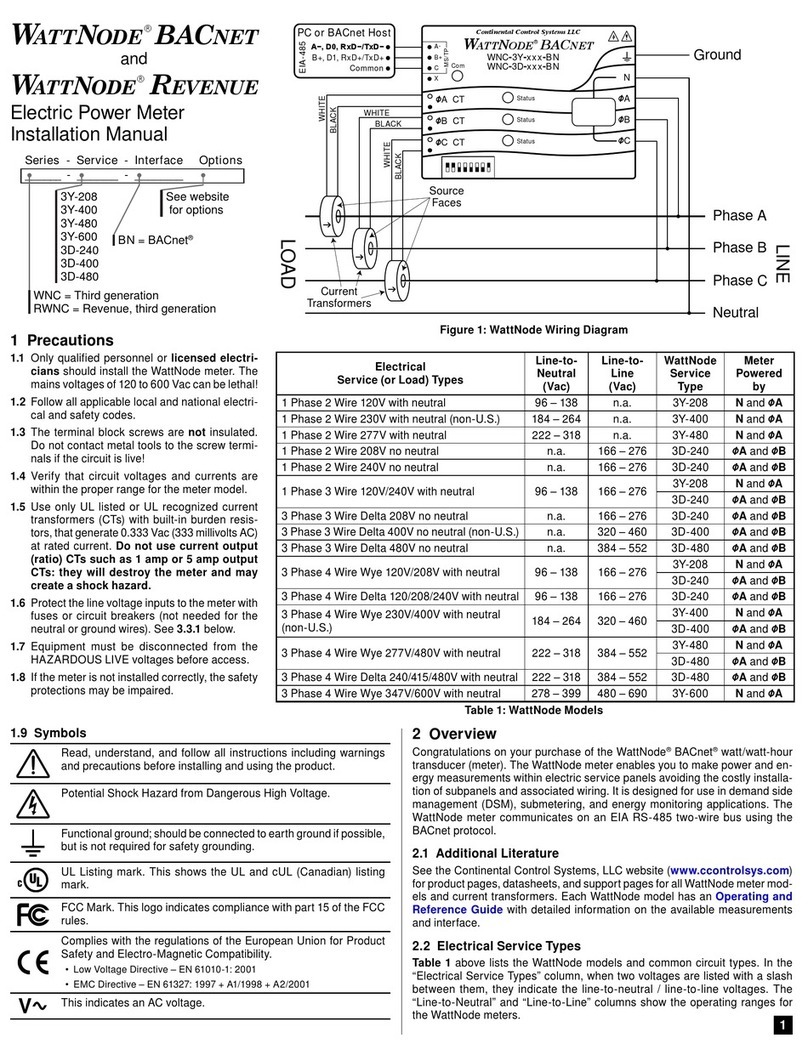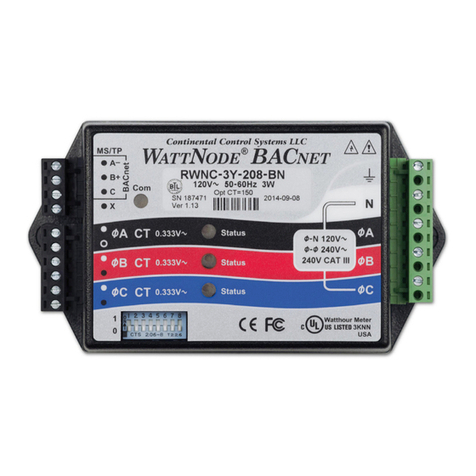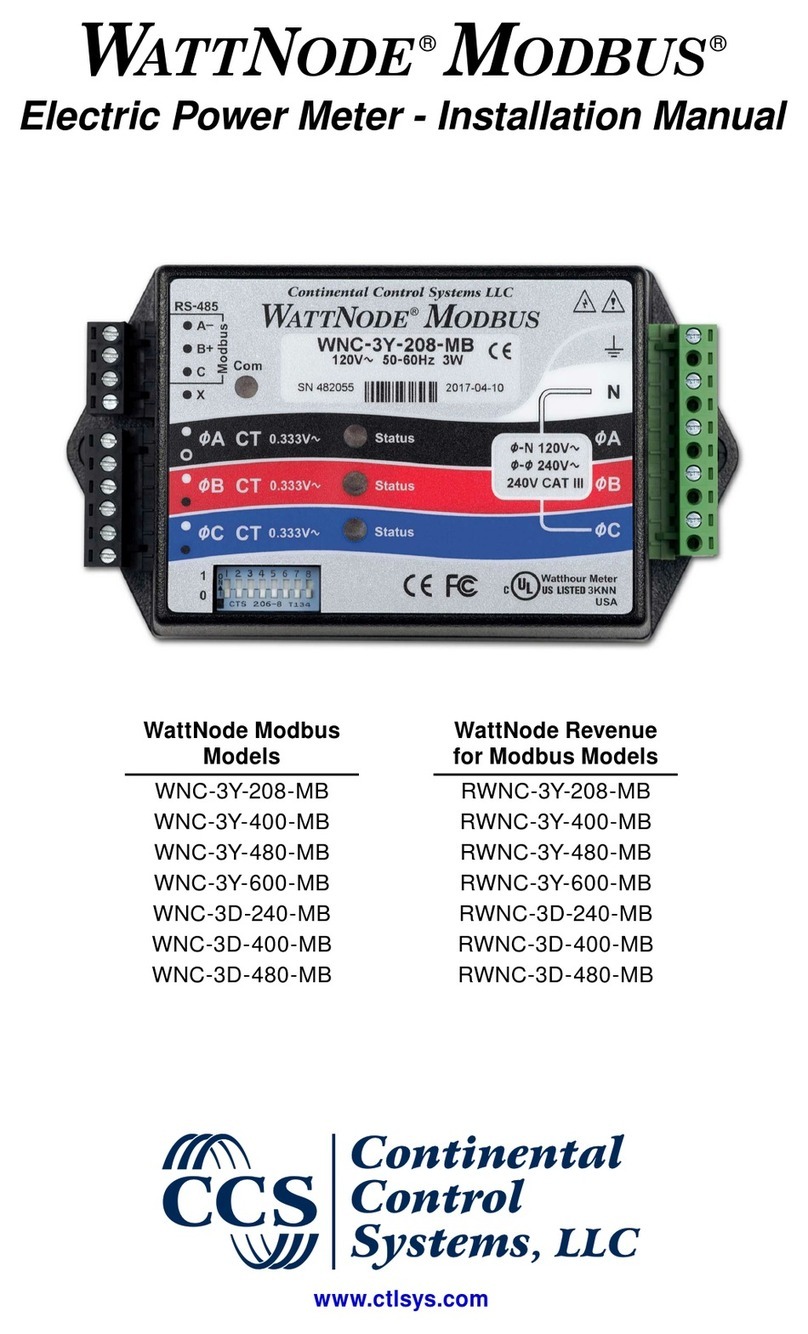
3
3.3 Connect Voltage Terminals
3.3.1 Circuit Protection
The WattNode meter is considered “permanently connected equipment” and
requires a disconnect means (circuit breaker, switch, or disconnect) and over-
current protection (fuse or circuit breaker).
The meter only draws 10-30 milliamps, so the rating of any switches, discon-
nects, fuses, and/or circuit breakers is determined by the wire gauge, the mains
voltage, and the current interrupting rating required.
●The switch, disconnect, or circuit breaker must be as close as practicable
to the meter and must be easy to operate.
●Use circuit breakers or fuses rated for 20 amps or less.
●Use ganged circuit breakers when monitoring more than one line voltage.
●The circuit breakers or fuses must protect the mains terminals labeled
ØA, ØB, and ØC. If neutral is also protected, then the overcurrent protec-
tion device must interrupt both neutral and the ungrounded conductors
simultaneously.
●The circuit protection / disconnect system must meet IEC 60947-1 and IEC
60947-3, as well as all national and local electrical codes.
3.3.2 Line Wiring
● Always disconnect power before connecting the line voltage inputs to
the meter.
● For the line voltage wires, CCS recommends 16 to 12 AWG stranded wire,
type THHN, MTW, or THWN, 600 V.
●Do not place more than one voltage wire in a screw terminal; use separate
wire nuts or terminal blocks if needed.
● Verify that the line voltages match the line-to-line Ø-Ø and line-to-neutral
Ø-Nvalues printed in the white box on the front label.
Connect each line voltage to the appropriate phase; also connect ground and
neutral (if applicable). The neutral connection “N“ is not required on delta mod-
els (3D-240, 3D-400, and 3D-480), but we recommend connecting it to ground
if neutral is not present.
The screw terminals handle wire up to 12 AWG. Connect each voltage line to
the green terminal block as shown in Figure 1 above. After the voltage lines
have been connected, make sure both terminal blocks are fully seated in the
meter.
When power is first applied, check that the LEDs behave normally: on models
with status LEDs, if you see them flashing red-green-red-green (see Figure 7),
the line voltage is too high for this model, so disconnect the power immediately!
3.3.3 Grounding
The WattNode uses a plastic enclosure, insulation, and internal isolation bar-
riers instead of protective earthing. The ground terminal on the green screw
terminal block is a functional ground, designed to improve the measurement
accuracy and noise immunity. If necessary, this terminal may be left discon-
nected on wye models (-3Y).
3.4 Connect Current Transformers
To meet the UL listing requirements, the WattNode meter may only be used
with the following UL listed or UL recognized voltage output current transformer
models. These all generate 333.33 millivolts AC at rated current. See the cur-
rent transformer datasheets for CT ratings.
ACT-0750-xxx CTL-1250-xxx CTM-0360-xxx
CTS-0750-xxx CTS-1250-xxx CTS-2000-xxxx
CTB-wwwXhhh-xxxx CTBL-wwwXhhh-xxxx CTT-0300-xxx
CTT-0500-xxx CTT-0750-xxx CTT-1000-xxx
CTT-1250-xxx
●“xxx” indicates the full scale current rating.
●“www” and “hhh” indicate the width and height in inches.
●“dddd” indicates the opening diameter of the loop for flexible Rogowski
CTs.
See the web article Selecting Current Transformers for information on se-
lecting appropriate current transformers (CTs).
●Do not use ratio or current output CTs such as 1 amp or 5 amp output
models!
●See the CT datasheets for the maximum input current ratings.
●Be careful to match the CTs with the voltage phases. Make sure the ØA CT
is measuring the current on the same phase being monitored by ØA, and
the same for phases B and C. Use the supplied colored labels or colored
tape to identify the CT leads.
●To minimize current measurement noise, avoid extending the CT wires,
especially in noisy environments. If it is necessary to extend the wires, use
twisted pair wire 22 to 14 AWG, rated for 300 V or 600 V (not less than the
service voltage) and shielded if possible.
●Find the source arrow or label “THIS SIDE TOWARD SOURCE” on the CT
and face/point toward the source of current.
●OPTIONAL: if you see spurious readings on unused phases, jumper the
unused CT inputs: for each unused CT, connect a short wire from the
terminal marked with a white dot to the terminal marked with a black dot.
To install the CTs, pass the conductor to be measured through the CT and con-
nect the CT leads to the meter. Always remove power before disconnecting
any live conductors. Put the line conductors through the CTs as shown in
Figure 1 above.
CTs are directional. If they are mounted backwards or with their white and black
wires swapped the measured power will be negative.
Split-core CTs can be opened for installation around a conductor. A nylon cable
tie may be secured around the CT to prevent inadvertent opening.
3.4.1 CT Wiring
Connect the white and black CT wires to the meter terminals marked ØA CT,
ØB CT , and ØC CT (see Figure 1 above). Excess length may be trimmed from
the wires if desired. The current transformers connect to the six position black
screw terminal block. Connect each CT with the white wire aligned with the
white dot on the label, and the black wire aligned with the black dot. Note the
order in which the phases are connected, as the line voltage phases must
match the current phases for accurate power measurement.
3.5 Connect the Output Signals
●The meter outputs are isolated from dangerous voltages, so you can con-
nect them at any time.
●If the output wiring is near line voltage wiring, use wires or cables with a
300 V or 600 V rating (not less than the service voltage).
●If the output wiring is near bare conductors, it should be double insulated
or jacketed.
●You may install two wires into each screw terminal by twisting the wires to-
gether, inserting them into terminal, and securely tightening. Note: a loose
wire can disable an entire network section.
●Use twisted-pair cable (unshielded or shielded) to prevent interference.
3.5.1 LonWorks FT-10 Network Wiring
CCS recommends that an experienced LonWorks network installer be con-
sulted for network design, particularly for the areas of topology, repeaters,
wiring, and termination. See the Operating and Reference Guide for more
details on LonWorks networks.
●The meter’s FT10 outputs are completely isolated from all dangerous volt-
ages, so you can connect them at any time with the meter powered.
●Connect the network wiring to the two circuit black terminal block labeled
FT10 and tighten the screws. The FT-10 twisted pair network is not polar-
ized, so either network wire can be connected to either screw terminal.
●FT-10 wiring may be daisy-chained between meters, with up to 127 devices
per subnet. The protocol has limits on the total wire length as well as stub
lengths, so see LonWorks FT-10 documentation for details and recom-
mended cabling.
ATT
ODE
WATTNODE
FT
10
FT10
FT10
●Once the meter is connected to the network and power is applied, configure
it on the LonWorks network using any of the following:
●Enter the meter information into the network management software and
press the service pin (button) on the meter when prompted. The service
pin is located on the side of the case to the left of the service LED.



























